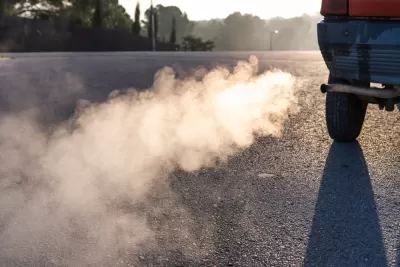A rule shelved during the Trump administration would require states and metropolitan areas to set targets for reducing tailpipe emissions, but advocates say it doesn’t go far enough to mandate results.

According to an article by Jared Brey in Governing, “A recently proposed federal rule would require states and metropolitan planning organizations to set targets for reducing tailpipe carbon emissions on portions of the national highway system that are within their boundaries, and to publicly monitor progress toward those goals.”
First proposed during the Obama administration and rescinded by President Trump’s administration, the rule is being revived to help bring states in line with national emission reduction goals. “Coupled with billions of dollars from the Infrastructure Investment and Jobs Act for carbon reduction and electric vehicle infrastructure — and more modest sums for multimodal transit planning — the administration hopes the rule will help states and metropolitan areas make fewer climate-damaging transportation decisions.”
While the FHWA says the rule, which offers flexibility to states and regions on setting targets and strategies for achieving them, should help “inform better decisions,” critics warn that it “won’t have a real impact on overall emissions without changes to the way mass transit and highway projects are funded.” Advocates say the federal government could do more to require climate considerations and emissions reduction strategies, calling this rule a welcome but inadequate step to address the urgency of the moment.
FULL STORY: States to Target Lower Transportation Emissions Under Proposed Rule

Alabama: Trump Terminates Settlements for Black Communities Harmed By Raw Sewage
Trump deemed the landmark civil rights agreement “illegal DEI and environmental justice policy.”

Planetizen Federal Action Tracker
A weekly monitor of how Trump’s orders and actions are impacting planners and planning in America.

The 120 Year Old Tiny Home Villages That Sheltered San Francisco’s Earthquake Refugees
More than a century ago, San Francisco mobilized to house thousands of residents displaced by the 1906 earthquake. Could their strategy offer a model for the present?

Ken Jennings Launches Transit Web Series
The Jeopardy champ wants you to ride public transit.

BLM To Rescind Public Lands Rule
The change will downgrade conservation, once again putting federal land at risk for mining and other extractive uses.

Indy Neighborhood Group Builds Temporary Multi-Use Path
Community members, aided in part by funding from the city, repurposed a vehicle lane to create a protected bike and pedestrian path for the summer season.
Urban Design for Planners 1: Software Tools
This six-course series explores essential urban design concepts using open source software and equips planners with the tools they need to participate fully in the urban design process.
Planning for Universal Design
Learn the tools for implementing Universal Design in planning regulations.
Clanton & Associates, Inc.
Jessamine County Fiscal Court
Institute for Housing and Urban Development Studies (IHS)
City of Grandview
Harvard GSD Executive Education
Toledo-Lucas County Plan Commissions
Salt Lake City
NYU Wagner Graduate School of Public Service





























